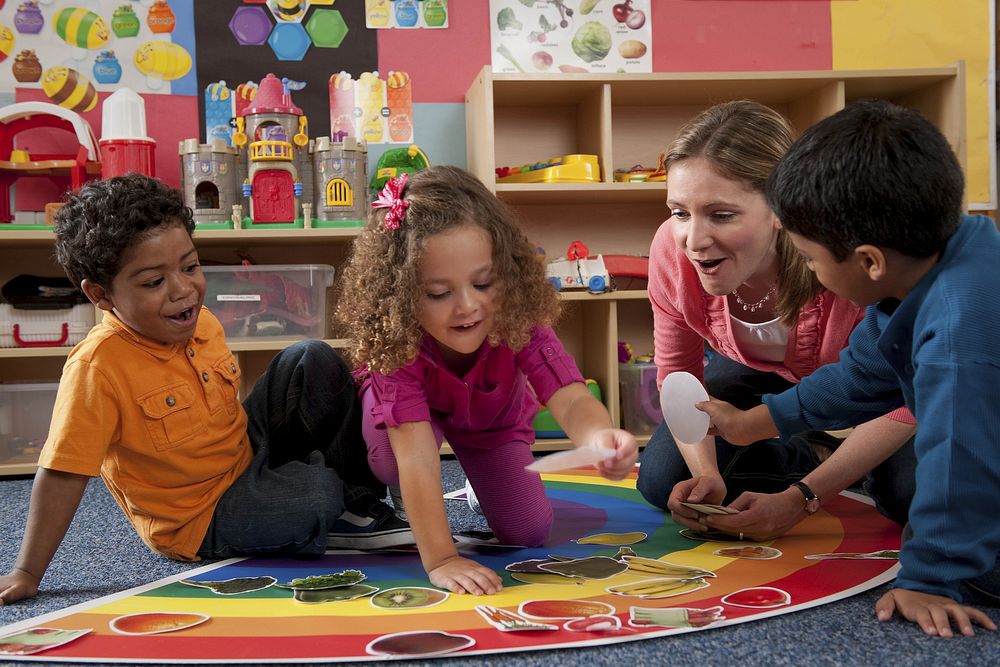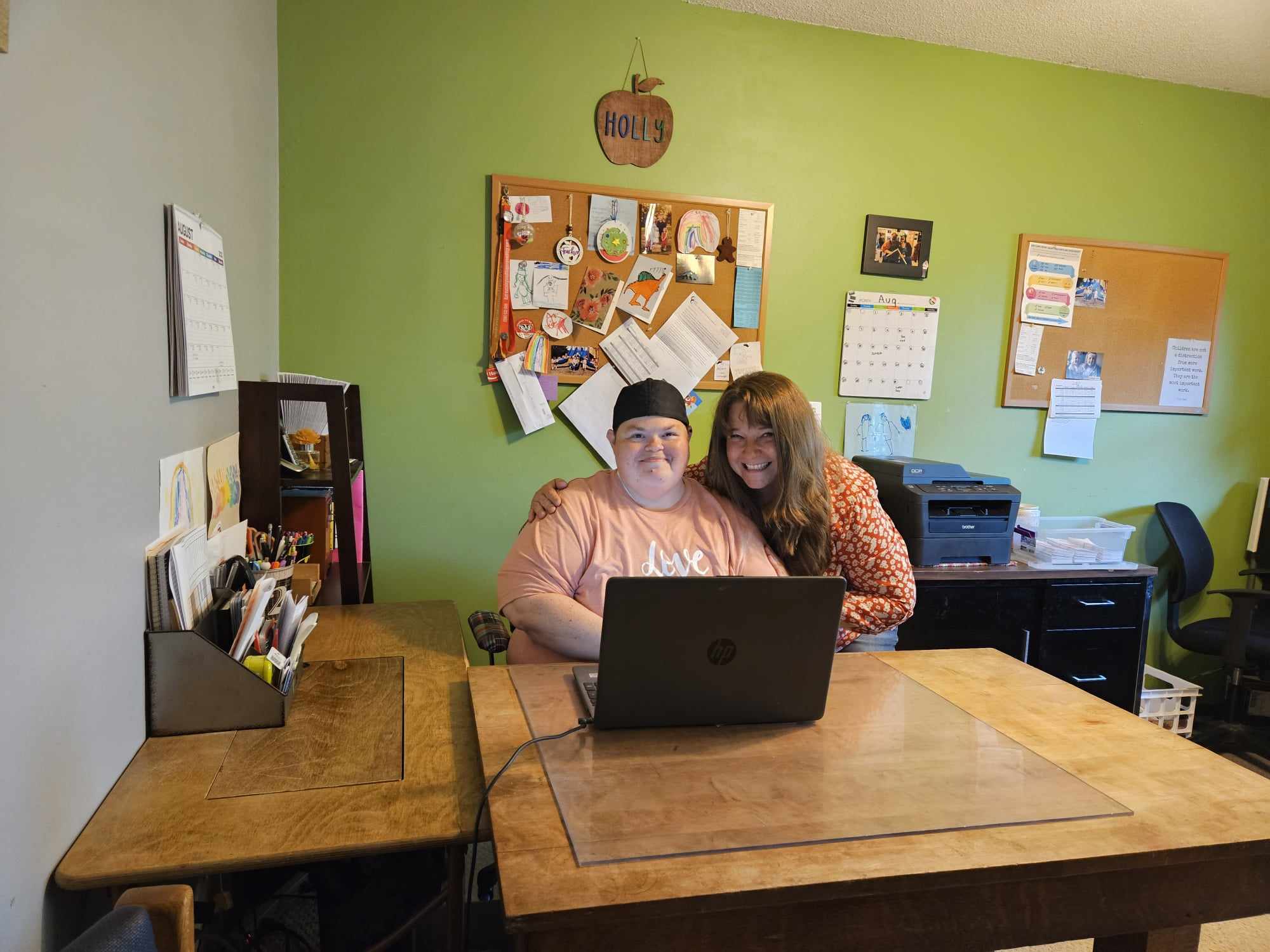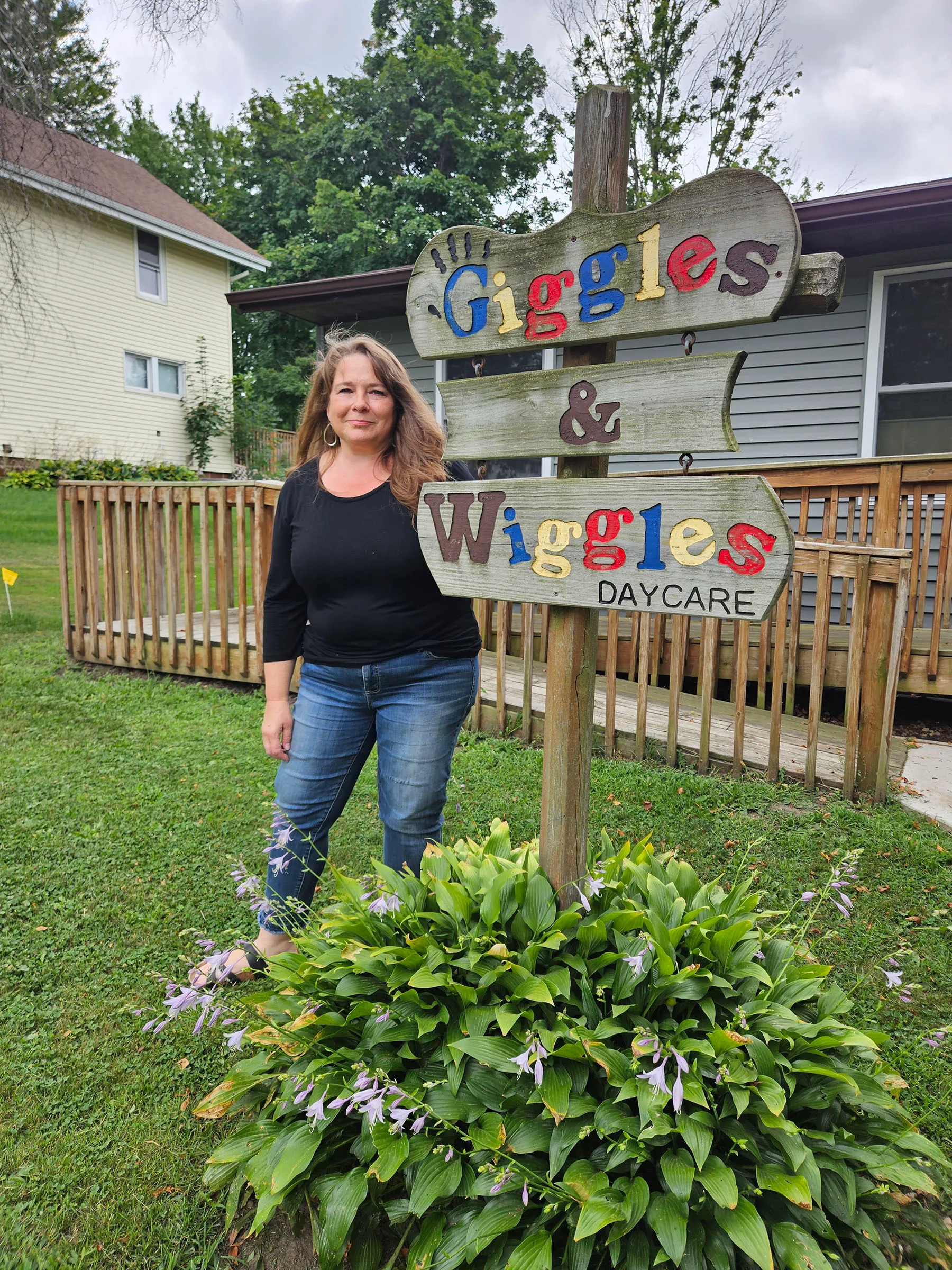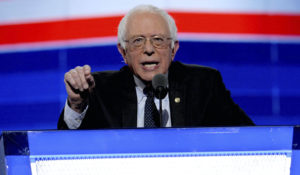When a Child Care Center Closes, an Entire Community Is Affected
As many as 70,000 child care centers are projected to close in the next several months as pandemic-era federal funding ends, pushing an industry already in crisis to a breaking point. Preschool students and teacher by Department of Agriculture via Flickr / CC BY-SA 3.0
Preschool students and teacher by Department of Agriculture via Flickr / CC BY-SA 3.0
Originally published by The 19th.
We’re telling the untold stories of women, women of color and LGBTQ+ people. Sign up for our daily newsletter.
When a teacher called in sick one Thursday in July, administrator Holly Denman realized she’d have to close her center for the day. Then it was two days. Giggles & Wiggles Daycare Center was as short staffed as it could be: six teachers, including Denman, for 34 students with absolutely no reserves or substitutes to tap into. One teacher out meant automatic closure.
By the next Sunday, two more teachers called out sick with a stomach bug and another with a migraine. They’d have to close Monday, too.
Monday morning, owner Kristin Holman-Steffel received eight calls in one hour from parents concerned something was amiss at Giggles & Wiggles. The center, which Holman-Steffel started from her converted home, is one of only three in Lancaster, Wisconsin, a three-square-mile town of just under 4,000 people in the southwestern tip of the state.
Holman-Steffel called Denman, who was in tears.
The administrator had been working to hire more staff with $4,000 Giggles & Wiggles had been receiving monthly since 2022. That money came through a federal program that pumped $24 billion in grants to child care centers across the country to keep them running during the pandemic — part of the single largest investment in child care in American history.
In two months, Denman spent seven times her advertising budget to run sponsored ads on Indeed to try to attract candidates, but of the few prospects who applied, even fewer answered a follow-up call. She scheduled interviews for people who never showed. She even offered positions to three candidates, but only one ever came to the job. All of that amounted to one hire in almost two months of nonstop recruiting.
The pandemic child care money helped keep Giggles & Wiggles going. Combined with a tuition increase, the funds helped raise wages by $2 to about $14 an hour on average in the fall of 2022, but it still wasn’t nearly enough to attract job candidates to the center. Child care workers in Wisconsin and everywhere in the United States are in the bottom 2 percent of jobs in terms of pay, along with fast food cooks and theme park workers. The local McDonalds advertises $13 an hour — $12 at the Piggly Wiggly.
For parents whose kids are in child care, there is little disagreement about the importance of funding the industry and paying teachers well.
By June, the federal child care money that Giggles & Wiggles and all those other centers have been relying on started to run out. In Wisconsin, monthly payments were cut in half. Nationally, the entire $24 billion pot of money is set to expire September 30. The money was always meant to be temporary, but in an industry that has existed almost only in crisis mode, centers did whatever they could to keep their staff, keep their families and keep their doors open. Most used the money to raise wages and keep tuition flat, but now without the funding, that business model is about to blow up.
And so when Holman-Steffel called that Monday in late July, Denman already knew their options had been exhausted. Another staffer also called in that day to say she’d be leaving for another job with more pay. She was a single mom whose rent was rising.
It was Holman-Steffel who said the words first.
“I don’t want to close,” Denman replied. She could work every day, take no days off, no breaks, cover classrooms. But she was one person, Holman-Steffel pointed out, and they were short almost an entire staff.
“How is there any other way out of this?” Holman-Steffel asked her. “What more can we do?”
That afternoon, on July 24, they notified the 27 families they served that after 26 years in operation, Giggles & Wiggles would close permanently on August 31. “We have cared for generations of children and families,” the note to parents read.
In the weeks since, the impact of that decision has reverberated across Lancaster.
One of the two other day care centers in town, even smaller than Giggles & Wiggles, is already fully booked. The other is having to leave its building for an even tinier location and will have to downsize. A third is expected to open in January with initial capacity for 75 kids, and demand is already high.
Parents are putting their kids on waiting lists for care in neighboring cities. They’re considering reducing their work hours or asking grandparents to watch their kids. One family is going to try to care for their child indefinitely while they work from home. A mom told Holman-Steffel she was putting her plans for another child on hold. She had expected Giggles & Wiggles could care for them.

Giggles & Wiggles is a preview of what could happen to other centers in other towns after September 30. The day has been referred to as a “child care cliff,” but that’s something of a misnomer. The impact will play out over time, in parts. Classrooms will close first; day care hours will be cut to save on staff. States that have tried to add bits of additional child care funding might hold on longer. A 30 percent increase in the federal subsidy program for low-income children in child care, the Child Care and Development Block Grant, will help somewhat. So too will a second, much smaller pot of $15 billion in federal pandemic money that will run out at the end of September 2024.
But providers will close, said Lauren Hogan, the managing director of policy and professional advancement at the National Association for the Education of Young Children.
It’ll just be more like quicksand than a sudden drop-off.
“It is going to suck people under,” Hogan said. “The pervasive sense is one of fear and foreboding in the field.”
By one projection, there could be as many as 70,000 closures. 70,000 Giggles & Wiggles.
When a child care center closes, especially in a small town, it frays the ties that keep a community together. Children become scattered, separated from the only caregivers most had ever known. Families are left scrambling to find alternate care in a system known for years-long waiting lists. And working parents are stymied, making impossible decisions around leaving their jobs or cutting back hours.
For parents whose kids are in child care, there is little disagreement about the importance of funding the industry and paying teachers well. But at the state and federal level, child care has been treated like a political afterthought, cast aside as a nice-to-have in a country that has long viewed child care as a “family problem,” not a government one.
When Wisconsin’s Republican-led Joint Finance Committee decided not to permanently fund an extension of the federal funds earlier this year — what would’ve been a $340 million investment — its justification was that the COVID child care funds were just one-time funds, and the budget had to prioritize funding existing programs like K-12 education, even if Wisconsin has a projected $4 billion budget surplus in its general fund this year. Democratic Gov. Tony Evers has since called for a special session to address the child care issue — one of his top priorities — proposing adding that $340 million back into the budget to continue monthly payments for two more years. Ultimately, that is money that will also run out. Evers visited Giggles & Wiggles in August after news of the closure spread. But advocates hold little hope that the session will result in anything at all.
“It’s a political hot potato right now. I think part of it is a disbelief that things aren’t gonna get as bad as we anticipate they’ll get,’” said Ruth Schmidt, the executive director of the Wisconsin Early Childhood Association, an advocacy organization. “This industry is made up of, in Wisconsin, close to 98 percent women. Plain and simple: We take advantage of it.”
The child care workforce, largely women of color, is one of the most precarious in the country. While almost every industry has recovered to pre-pandemic numbers, child care is still short 5 percent of its early 2020 workforce.
It’s a similar story across the country: As the federal funds dry up, long-term funding proposals are unlikely to pass at the federal level to fill that billion-dollar-sized gap, and only eight states have passed additional child care funding using their own funds. The child care workforce, largely women of color, is one of the most precarious in the country. While almost every industry has recovered to pre-pandemic numbers, child care is still short 5 percent of its early 2020 workforce.
The stabilization funds helped keep centers that were on the edge of closure open, but only just barely. More than half of workers reported getting pay bumps, money that kept them in industry instead of jumping ship to work at Walmart or Target or the local school district. The rest of the money went to help pay for rent and supplies, which also rose as inflation ballooned.
All of those problems remain, but soon the money will be gone. For centers that have staved off closure, most of the costs will get passed on to parents in the form of tuition hikes in the fall that could push the most vulnerable kids out of care. More than a third of programs serving infants and toddlers expect to raise rates after the funding runs out, according to a May survey of providers. Already, the annual cost of child care exceeds the cost of in-state public university tuition in 34 states, and that cost has been rising at a faster rate than inflation for three decades.
But before widespread closures, services will contract and costs to parents will increase. It’s already happening.
Deanne Patten, the owner of Firehouse Friends Childcare Center in Stanley, Wisconsin, has implemented a rate hike more than six times higher than her usual increase — the highest ever in the center’s nine years — because starting hourly wages for staff went up from as low as $9 to as high as $16 with the federal funds. The hike, $180 to $260 a month per child, went into effect this week. She waited to see if Wisconsin would implement additional funds for child care, but when it became clear it wasn’t happening, she had to raise tuition. The day she told parents about the changes, she watched the stress wash over their faces. Patten said she was so overwhelmed she stopped eating, lost weight. “It was probably the worst thing I have done in my life,” she said.
Rates at TLC for Tots in Nampa, Idaho, are rising by nearly $200 a month for infant care, and already families are leaving. Other parents have declined promotions to avoid earning too much money to disqualify them from their child care subsidies, said director Krystal McFarlane.
She had no choice in the tuition hikes, she said. Even the cost of a box of rubber gloves that providers use for diaper changes has tripled, shooting from $33 to $99. She already had to cut six positions over the summer, and staff bonuses ended in June along with the federal funding. McFarlane’s parents have owned the business for 17 years, taking no pay for themselves for two years during the pandemic. TLC for Tots was supposed to be her business one day — the future for the single mom and her two kids. Instead, in the next three months, she’ll have to decide if they have to close.
When Giggles & Wiggles’ owner and administrator made their decision in July, Heidi Nelson remembers the panic that she felt instantly. Two years ago, when she was looking for a day care that could take her now 3-year-old son, Alex, she “called everywhere and [Giggles & Wiggles] were really the only ones who were even willing to listen to us.” Alex has autism, and many of the centers would not accommodate him. If another didn’t take him, would she have to ask her husband, who just started a full-time job, to quit his? Would she have to consider changing her own work hours or asking her dad, who is 69, to take on more of Alex’s care?
When Denman took on Alex, she converted the day care for his safety. They put food labels on everything to ensure he did not eat anything that would trigger his dairy, soy and wheat allergies. Giggles & Wiggles changed its policy so kids could no longer bring their own breakfast — they would all wait to eat together so that Alex was safe. The families rallied. “We are a small town,” Nelson explained.
Alex is nonverbal, and the staff learned to pick up on his cues. They knew when he needed a break if the other kids were being too loud and set him up in a corner with a couple of toys away from the chaos.
After Nelson learned of the closure, it took three weeks of calling around before she finally found another private preschool in town that will take Alex in the afternoons after he has school — the director has a grandson with autism, but doesn’t normally serve children with autism.
“The first question was, ‘What are his behaviors?’” Nelson said. “It’s just a gut-wrenching question because 99 percent of the time he is a great kid. His behaviors stem from not being able to communicate his wants and needs.”
The week before Giggles & Wiggles closed, Alex had bitten a few kids and the staff had called right away to see if Nelson had some insight on what was causing it. She did. As the center prepared to close, parents had already pulled out their kids and the staff had consolidated everyone into one classroom. Alex was struggling to handle that change.
Nelson fully expects he may only last a couple of weeks in the new preschool before he’s kicked out.
“I just keep thinking about, ‘Are they going to give up on him too soon because they don’t know him and they aren’t going to take the time to get to know him?’” Nelson said.
It’s the top thing on Denman’s mind, too.
“I just think people are just going to see he’s high maintenance, but they are not going to enjoy that he is also super sweet and loves to snuggle and loves hugs and is just super goofy,” Denman said. “He’s been my boy for so long, now I worry somebody else isn’t going to love him the way he deserves,” she said.

Giggles & Wiggles hasn’t just been a job for Denman and Holman-Steffels. It’s been a community. It’s been about the back-to-school potlucks for all the parents and the Halloween open house, the library art show. It was about when a storm knocked down a tree and a dad offered to saw off the broken limb. Or the time parents chipped in to rent out an ice cream truck to deliver cones for all the kids.
“When you care for their children for 10 hours a day, you really get to be part of that family’s life,” Holman-Steffels said. Now that the center is closing, “you just feel like you’re letting everybody down.”
As the staff got ready for the final day, Denman said she couldn’t bring herself to throw a party. Instead she’d continue to let the kids do what they liked, pulling toys out of storage and rearranging the play area at the gray home that has housed more than enough giggles and wiggles to earn its name.
Denman has no plan for what’s next.
“I’m so heartbroken over losing my kids,” she said, “I don’t feel like I can walk in somewhere else and love other kids.”
Independent journalism is under threat and overshadowed by heavily funded mainstream media.
You can help level the playing field. Become a member.
Your tax-deductible contribution keeps us digging beneath the headlines to give you thought-provoking, investigative reporting and analysis that unearths what's really happening- without compromise.
Give today to support our courageous, independent journalists.






You need to be a supporter to comment.
There are currently no responses to this article.
Be the first to respond.